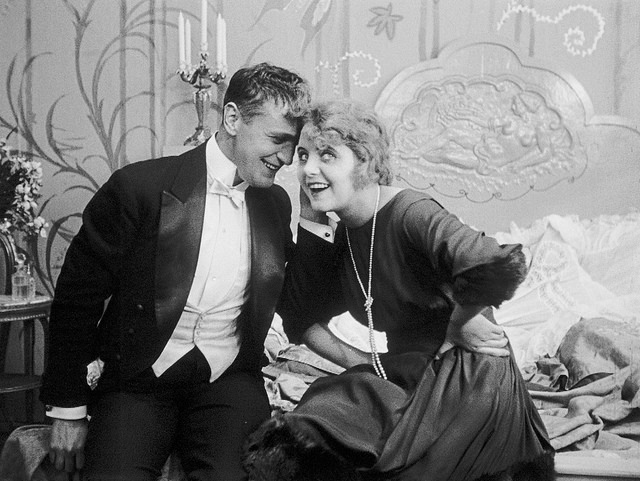
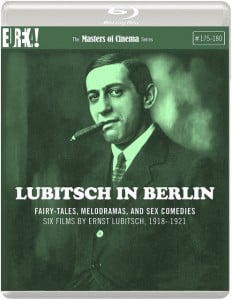 ICH MÖCHTE KEIN MANN SEIN (I DON’T WANT TO BE A MAN) Dir.: Ernst Lubitsch; Cast: Ossi Oswalda, Curt Goetz; Germany 1918, 45 min. (Silent)
ICH MÖCHTE KEIN MANN SEIN (I DON’T WANT TO BE A MAN) Dir.: Ernst Lubitsch; Cast: Ossi Oswalda, Curt Goetz; Germany 1918, 45 min. (Silent)
DIE PUPPE (THE DOLL) | Dir.: Ernst Lubitsch; Cast: Ossi Oswalda, Hermann Thimig, Victor Janson; Germany 1919, 48 min. (Silent) |
DIE AUSTERN PRINZESSIN (THE OYSTER PRINCESS) | Dir. Ernst Lubitsch; Cast: Ossi Oswalda, Victor Janson, Harry Liedtke, Julius Falkenberg; Germany 1919, 58 min. (Silent)
SUMURUN | Dir.: Ernst Lubitsch; Cast: Ernst Lubitsch, Pola Negri, Paul Wegener, Jenny Hasselqvist; Germany 1920, 85 min. (Silent)
ANNA BOLEYN (DECEPTION) | Dir.: Ernst Lubitsch; Cast: Henny Porten, Emil Jannings, Paul Hartmann, Ludwig Hartau
DIE BERGKATZE (THE MONTAIN CAT) | Dir.: Ernst Lubitsch; Cast: Pola Negri, Victor Janson, Paul Heidemann, Wilhelm Diegemann, Hermann Thimig, Edith Meller; Germany 1921, 79 min.
In From Caligari to Hitler, Siegfried Kracauer’s pre-eminent history of the German film between the two world wars, Ernst Lubitsch dominates the chapter entitled The Shock of Freedom, dealing with the films which followed the Armistice in 1918. Kracauer is not uncritical of Lubitsch’ four ‘blockbusters’ – Sumurun and Anna Boleyn are in this collection of six Lubitsch films – (the others were Madame DuBarry and The Loves of Pharaoh) – the author is emphatic: were it not for Lubitsch, “the German film comedies of the time would hardly be worth mentioning”. As it turns out, the comedies are in a way much more impressive than the big productions: they so much more innovative, and even anarchic. Many of Lubitsch’ collaborators went on to enjoy long careers, often in Hollywood, as did the director himself.
Unfortunately LUBITSCH IN BERLIN does not include Paul Davidson, who was a well-known actor and chief-executive of UFA after the merger with Deulig. He became the producer of 39 Lubitsch films in Berlin. Some time after the director left for Hollywood in 1922, Davidson committed suicide but while he produced all six films, the actress Ossi Oswalda was the star of the three Lubitsch comedies I Don’t Want to Be a Man, The Doll and The Oyster Princess. Oswalda was the German Mary Pickford. She starred in 51 films between 1916 and 1933 – but could not adjust to sound films and died in poverty in Prague in 1947, four month before Lubitsch’ own demise in Hollywood. Script-writer Hanns Kraly, who was co-writer with Lubitsch for the films of this collection, followed Lubitsch to Hollywood, where they worked together again for Eternal Love (1929). Kraly has over 87 credits, among them 100 Men and a Girl and It Started with Eve. And last, but not least the masterful DoP Theodor Sparkuhl was behind the camera, not only for the films in this collection, but in a career that spanned over hundred features. He working in France and Hollywood after leaving Germany in 1928. Highlights were Renoir’s La Chienne, as well as Beau Geste and The Glass Key in Hollywood.
In I Don’t Want to Be a Man, Ossi Oswalda plays a teenage tomboy under the power of a draconian governess and a even more dictatorial and moralistic guardian (Curt Goetz). When Ossi has enough, she buys herself a tailored suit, dresses like a man and goes to a ball where she meets her guardian, who does not recognize her. The two get drunk together, even kiss, and in the morning Ossi is not only in love with her former tormentor, but wants to remain a woman for the rest of her life. The ball scenes are exceptional, Lubitsch’ talent for crowd scenes is perfectly showcased. Oswalda is very convincing in both roles, exuding a charming playfulness that outshines the rest of the cast.
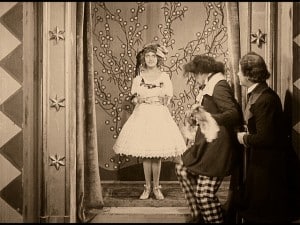 The Doll is the most innovative of the three medium length features. The Baron of Chanterelle is dying, and wants his nephew Lancelot (Thimig) to marry, so the bloodline can continue. But Lancelot is afraid of women, and he flees into a cloister to get away from it all. But the monks are only interested in eating and drinking, and once they find out that Lancelot is heir to a fortune they hatch a scheme to get their hands on the money, convincing the young man to marry a mechanical doll, perfectly produced by master constructor Hilarius (Janson). But Hilarious’ apprentice accidentally destroys the doll, and his daughter (Oswalda) takes over in an amusing performance. The crowd scenes are magnificent, played out against the backdrop of a Grimm Brother’s design. The Doll is an early comedy masterpiece.
The Doll is the most innovative of the three medium length features. The Baron of Chanterelle is dying, and wants his nephew Lancelot (Thimig) to marry, so the bloodline can continue. But Lancelot is afraid of women, and he flees into a cloister to get away from it all. But the monks are only interested in eating and drinking, and once they find out that Lancelot is heir to a fortune they hatch a scheme to get their hands on the money, convincing the young man to marry a mechanical doll, perfectly produced by master constructor Hilarius (Janson). But Hilarious’ apprentice accidentally destroys the doll, and his daughter (Oswalda) takes over in an amusing performance. The crowd scenes are magnificent, played out against the backdrop of a Grimm Brother’s design. The Doll is an early comedy masterpiece.
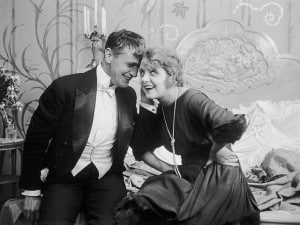 The same goes for the Oyster Princess, a satire on Hollywood films, where everything is over-cooked. The wealthy Oyster King (Janson) is tyrannized by his daughter overbearing (Oswalda) into find her a prince she can marry. Oswalda, who still sleeps with her teddy-bear, is not really after a husband, but wants to impress her contemporaries. The impoverished Prince Nicki (Liedtke) is chosen, but he sends his friend and servant Josef (Falkenstein) to have a look at Ossi. In a mix-up, Josef is taken for the real Prince, and Ossie marries him – but sends him away in the wedding night so she can go sharing her bed with her teddy. It all ends well but not before Lubitsch makes a fool out of the Hollywood style, in some scenes even outdoing his future employers; producing the kind of gags even the Marx Brothers would have been proud of!
The same goes for the Oyster Princess, a satire on Hollywood films, where everything is over-cooked. The wealthy Oyster King (Janson) is tyrannized by his daughter overbearing (Oswalda) into find her a prince she can marry. Oswalda, who still sleeps with her teddy-bear, is not really after a husband, but wants to impress her contemporaries. The impoverished Prince Nicki (Liedtke) is chosen, but he sends his friend and servant Josef (Falkenstein) to have a look at Ossi. In a mix-up, Josef is taken for the real Prince, and Ossie marries him – but sends him away in the wedding night so she can go sharing her bed with her teddy. It all ends well but not before Lubitsch makes a fool out of the Hollywood style, in some scenes even outdoing his future employers; producing the kind of gags even the Marx Brothers would have been proud of!
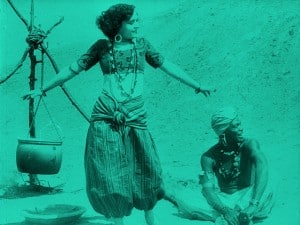 In Sumurun (An Arabian Night), based on Max Reinhardt’s stage production, Lubitsch himself plays Yeggar, a hunchback who denounces the love affair between the old Sheik’s (Wegener) son and his mistress, the dancer Yannaia (Pola Negri), to the vengeful ruler, who kills the couple. Realising his humanity, Yeggar then murders the old Sheikh. Kracauer had this to say about the 1920 silent film thus: “loaded with kisses and corpses, this story phantasy pretended superiority to its theme, by satirizing it pleasantly.”
In Sumurun (An Arabian Night), based on Max Reinhardt’s stage production, Lubitsch himself plays Yeggar, a hunchback who denounces the love affair between the old Sheik’s (Wegener) son and his mistress, the dancer Yannaia (Pola Negri), to the vengeful ruler, who kills the couple. Realising his humanity, Yeggar then murders the old Sheikh. Kracauer had this to say about the 1920 silent film thus: “loaded with kisses and corpses, this story phantasy pretended superiority to its theme, by satirizing it pleasantly.”
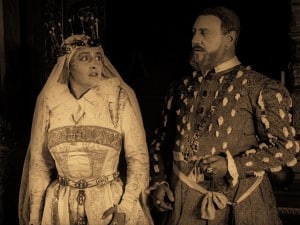 For Anna Boleyn (Deception) Lubitsch splashed out 8.5 million marks on this gruesome spectacle, that depicts Henry VIII’s lust for sex and murder. Torture scenes predominate, and, in contrast to Danton (1921), Lubitsch doesn’t need to embroider the facts as Henry VIII (Jannings) and Anna Boleyn (Porten) provided enough material to be exploited. Highlights are the murder of Boleyn’s lover and her own execution scene where the masses joined forces to converge on the Tower, giving Lubitsch an excuse to a chance to max out his crowd control mastery.
For Anna Boleyn (Deception) Lubitsch splashed out 8.5 million marks on this gruesome spectacle, that depicts Henry VIII’s lust for sex and murder. Torture scenes predominate, and, in contrast to Danton (1921), Lubitsch doesn’t need to embroider the facts as Henry VIII (Jannings) and Anna Boleyn (Porten) provided enough material to be exploited. Highlights are the murder of Boleyn’s lover and her own execution scene where the masses joined forces to converge on the Tower, giving Lubitsch an excuse to a chance to max out his crowd control mastery.
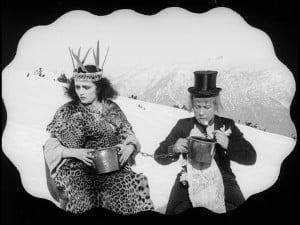 Finally, Die Bergkatze (The Mountain Cat) was a rare box-office failure for Lubitsch. In follows notorious Don Juan, Lieutenant Alexis (Heidemann) who seduces Lilli (Meller) the daughter of his fort commander (Janson). He’s also secretly in love with Rischka (Negri), leader of a robber gang, who infiltrates the fort. The two women fight for Alexis before Rischka ‘sees sense’ and gives Alexis up. Reinhardt’s stage designer Ernst Stern (who emigrated to London in 1933) was responsible for the innovative mixture of expressionism, Jugendstil and oriental fairytale. There are hardly any straight lines in the designs, everything is elliptic, full of scrolls and squiggles. Curved frames predominate this inventive silent film and, Lubitsch uses distorting mirrors for the dream-scenes to complete the magic of this highly unusual piece.
Finally, Die Bergkatze (The Mountain Cat) was a rare box-office failure for Lubitsch. In follows notorious Don Juan, Lieutenant Alexis (Heidemann) who seduces Lilli (Meller) the daughter of his fort commander (Janson). He’s also secretly in love with Rischka (Negri), leader of a robber gang, who infiltrates the fort. The two women fight for Alexis before Rischka ‘sees sense’ and gives Alexis up. Reinhardt’s stage designer Ernst Stern (who emigrated to London in 1933) was responsible for the innovative mixture of expressionism, Jugendstil and oriental fairytale. There are hardly any straight lines in the designs, everything is elliptic, full of scrolls and squiggles. Curved frames predominate this inventive silent film and, Lubitsch uses distorting mirrors for the dream-scenes to complete the magic of this highly unusual piece.
The last word should go to the pioneering Guardian film critic Caroline Alice) Lejeune (1897-1973) as quoted by Kracauer: “Lubitsch had a way of manipulating his puppets that gave multitude, and in contrast, loneliness, a new form. No one before had so filled and drained his spaces with wheeling masses, rushing in the figures from every corner to cover the screen, dispersing them again like a whirlwind, with one single figure staunch in the middle of the empty square” AS
LUBITSCH IN BERLIN | EUREKA MASTERS OF CINEMA | 18 SEPTEMBER 2017